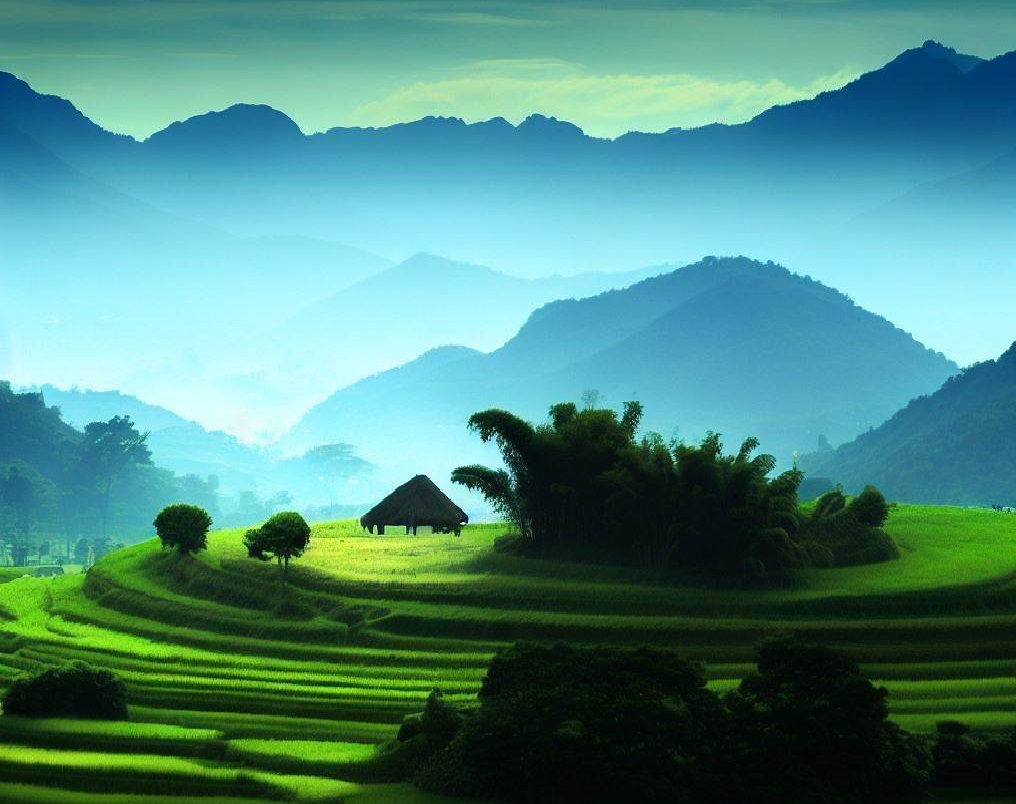Vietnam, a Southeast Asian country known for its rich history and vibrant culture, is also home to a diverse and awe-inspiring landscape. From rugged mountains to picturesque coastlines, tranquil countryside to pristine national parks, Vietnam landscape is a breathtaking tapestry of natural beauty. In this article, we will delve into the captivating landscapes that make Vietnam a true gem in the region.

Vietnam is a country that encompasses a wide range of geographical features, giving it a unique and varied landscape. Its natural beauty attracts tourists from all over the world who are eager to explore its hidden treasures. Let’s embark on a journey to discover the remarkable landscapes that make Vietnam a must-visit destination.
II. The Natural Beauty of Vietnam Lanscape

A. The Rugged Mountains
Vietnam boasts several majestic mountain ranges that offer stunning views and thrilling adventures. Among them, the Hoang Lien Son Range stands tall, stretching across the northwest region. Mount Fansipan, the highest peak in Indochina, is a popular destination for trekking enthusiasts seeking an exhilarating challenge.
Another notable mountain range is the Annamite Range, which extends along the border between Vietnam and Laos. Its lush green slopes are home to diverse flora and fauna, making it an ideal spot for nature lovers and wildlife enthusiasts.
B. The Breathtaking Coastline
Vietnam’s coastline is nothing short of spectacular, with pristine beaches and breathtaking islands dotting the shores. Ha Long Bay, a UNESCO World Heritage Site, is a true natural wonder. Its emerald waters are adorned with thousands of limestone karsts, creating a mesmerizing seascape that seems straight out of a fairytale.
Further south, Phu Quoc Island beckons with its idyllic beaches and vibrant coral reefs. This tropical paradise offers a serene escape where visitors can relax and immerse themselves in the beauty of the ocean.
C. Vietnam landscape: The enchanting rivers and deltas
Vietnam is blessed with rivers and deltas that sustain its agricultural communities and add to the country’s charm. The Mekong Delta, often referred to as the “Rice Bowl of Vietnam,” is a vibrant maze of waterways and lush paddy fields. Exploring this region by boat allows visitors to witness the daily life of locals and marvel at the
intricate network of canals and floating markets.
The Red River Delta, surrounding the capital city of Hanoi, is another captivating landscape. This fertile region is characterized by vast rice fields and quaint villages, offering a glimpse into traditional rural life in Vietnam.
III. Vietnam landscape: The Tranquil Countryside

A. The Picturesque Rice Terraces
Vietnam’s countryside is adorned with mesmerizing rice terraces that cascade down the hillsides. The terraced fields of Mu Cang Chai in the Northern Vietnam are particularly famous for their stunning beauty. These meticulously carved terraces change hues throughout the year, painting the landscapes of Vietnam with vibrant shades of green.
B. The Charming Villages
Scattered across the countryside are charming villages that exude a sense of tranquility and simplicity. Places like Mai Chau and Sapa offer visitors a chance to experience rural life firsthand, interact with local ethnic minority communities, and indulge in the serenity of nature.
C. The Lush Greenery
Vietnam’s countryside is a haven of lush greenery, with rolling hills, dense forests, and picturesque landscapes. From the serene landscapes of Ninh Binh, often referred to as “Halong Bay on land,” to the stunning beauty of the Central Highlands, where coffee and tea plantations thrive, nature lovers will find solace in the verdant embrace of Vietnam’s countryside.
IV. Vietnam landscape: The Pristine National Parks

A. Ba Be National Park
Nestled in the northeast region of Vietnam, Ba Be National Park is a hidden gem. Its centerpiece is the mesmerizing Ba Be Lake, surrounded by limestone mountains covered in dense forests. Exploring the park’s diverse ecosystem, including its caves, waterfalls, and rich biodiversity, is a treat for adventure seekers and nature enthusiasts.
B. Cat Ba National Park
Located in the breathtaking Cat Ba Archipelago, Cat Ba National Park offers a unique blend of land and marine landscapes. Home to the endangered langur species and a variety of other wildlife, the park is a paradise for nature conservationists. Hiking through its dense forests and exploring the pristine beaches and karst formations of Lan Ha Bay are unforgettable experiences.
C. Phong Nha-Ke Bang National Park
Recognized as a UNESCO World Heritage Site, Phong Nha-Ke Bang National Park is a treasure trove of natural wonders. It is home to the largest cave system in the world, including the awe-inspiring Son Doong Cave. Visitors can marvel at the park’s magnificent limestone formations, underground rivers, and enchanting biodiversity, making it a paradise for spelunkers and nature lovers alike.
V. Cultural Landscapes

A. Ancient Towns and Cities
Vietnam landscape is not just limited to natural beauty; it also encompasses culturally significant towns and cities. Hoi An Ancient Town, a UNESCO World Heritage Site, transports visitors back in time with its well-preserved architecture, vibrant lantern-lined streets, and rich cultural heritage. Hue Imperial City, the former capital of the Nguyen Dynasty, offers a glimpse into Vietnam’s imperial past through its majestic citadel, palaces, and temples.
B. The Hanoi Old Quarter
In the heart of Vietnam’s bustling capital, the Hanoi Old Quarter showcases a unique cultural landscape. Its narrow streets are filled with centuries-old architecture, traditional markets, and vibrant street food stalls, creating a lively atmosphere that reflects the city’s history and charm.
C. Religious and Historical Sites
Vietnam landscape is dotted with religious and historical sites that hold great significance. The Perfume Pagoda, located amidst a scenic landscape southwest of Hanoi, is a complex of Buddhist temples nestled within a limestone mountain
range. Pilgrims visit this sacred site, especially during the Perfume Pagoda Festival, seeking blessings and spiritual fulfillment.
The Temple of Literature in Hanoi is another remarkable cultural landmark. As Vietnam’s first national university, the temple is a testament to the country’s rich scholarly traditions. Its serene courtyards, traditional architecture, and stone steles honoring past scholars create a peaceful ambiance, making it a popular destination for locals and tourists alike.
Finally, Vietnam landscape is a tapestry of natural and cultural beauty, offering a diverse array of experiences for travelers. From the rugged mountains of the Hoang Lien Son and Annamite ranges to the breathtaking coastlines of Ha Long Bay and Phu Quoc Island, Vietnam captivates with its natural wonders. The tranquil countryside with its picturesque rice terraces and charming villages provides a peaceful escape. Pristine national parks like Ba Be, Cat Ba, and Phong Nha-Ke Bang offer opportunities for adventure and exploration. Lastly, the cultural landscapes of ancient towns, the Hanoi Old Quarter, and religious sites like the Perfume Pagoda and the Temple of Literature showcase Vietnam’s rich history and traditions.
Discovering Vietnam landscape is an immersive journey that engages all the senses, leaving lasting memories and a sense of awe. Whether exploring the natural wonders, delving into the countryside, or immersing oneself in the vibrant cultural heritage, Vietnam has something to offer for every traveler.
So, why wait? Embark on your own adventure and experience the captivating landscapes of Vietnam.
FAQs (Frequently Asked Questions)
1. When is the best time to visit Vietnam to experience its diverse landscapes?
The best time to visit Vietnam depends on the region you plan to explore. Generally, the months of April to June and September to December offer pleasant weather and fewer crowds. However, each season has its unique charm, so it’s essential to research and plan accordingly based on your preferences.
2. Are there any restrictions or permits required to visit the national parks in Vietnam?
Most national parks in Vietnam are open to visitors, but some may require permits or guided tours for certain areas, especially for ecologically sensitive regions. It’s advisable to check with local authorities or tour operators for specific park regulations and requirements before visiting.
3. Can I combine cultural and natural landscapes in my Vietnam itinerary?
Absolutely! Vietnam offers the perfect blend of cultural and natural landscapes. You can explore ancient towns and cities like Hoi An and Hue, then venture into the countryside to witness stunning rice terraces or visit national parks to experience the pristine beauty of nature. Customize your itinerary to include a mix of cultural and natural attractions that align with your interests.
4. What are some recommended outdoor activities in Vietnam landscape?
There are plenty of outdoor activities to enjoy in Vietnam’s diverse landscapes. Trekking in the mountains, kayaking in Halong Bay, cycling through the countryside, and cave exploration in national parks are just a few examples. Engaging in these activities allows you to fully immerse yourself in the natural beauty and adventure that Vietnam has to offer.
5. How can I support sustainable tourism while exploring Vietnam landscape?
To support sustainable tourism, consider booking with local tour operators or staying in eco-friendly accommodations that prioritize responsible practices. Respect the environment by following designated trails, reducing waste, and supporting local communities through responsible shopping and cultural exchanges. By being mindful of your impact, you can contribute to the preservation of Vietnam’s stunning landscapes for future generations.
